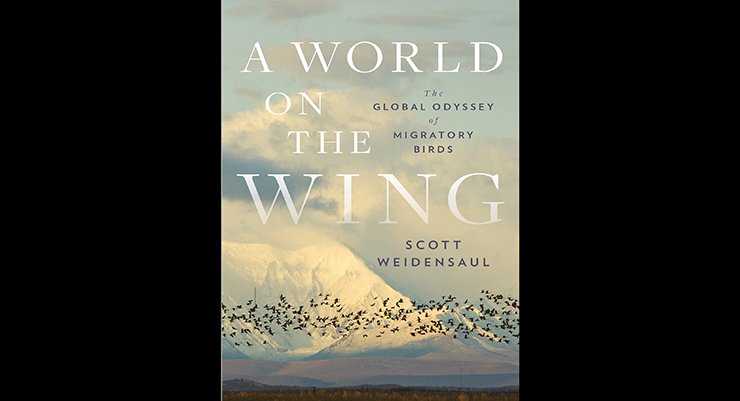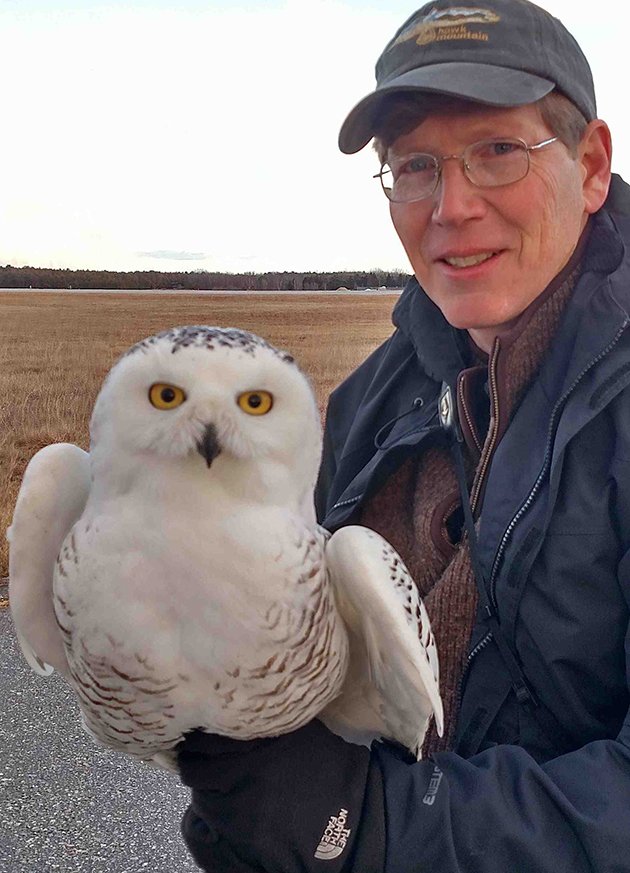
Ask any birder–migration is joy. It’s endless frustration that suddenly erupts into wild excitement, a reason to get up in the morning, a goal for the mind and a bandage for the soul as we muddle through winter and pandemic. It is also, as Scott Weidensaul makes clear in his new book, A World on the Wing: The Global Odyssey of Migratory Birds, a phenomenon that demands our close and continuing attention because by observing migration we (1) learn more about the evolutionary adaptations–sometimes commonsensical, sometimes mind blowing–that enable birds to migrate and thus survive, (2) become aware of how climate change and human actions are affecting migration patterns, bird survival, and by extension, our natural world. This is big, global-level stuff with amazing findings but worrisome data. Weidensaul, master nature writer, understands that the best way to communicate “big stuff” (my words, not his!) is through the personal and the specific. His second book on migration is a tale of many birds and many research studies all connected by the theme of migration and by his thoughtful narrative voice.
The book is organized into ten chapters, framed by a Prologue and Epilogue focused on Weidensaul’s banding experience in Denali National Park. Five chapters are profiles in ornithological adventure and challenge: Spoon-billed Sandpiper research in China; Kirtland Warbler research on their wintering grounds in the Bahamas; forty years of research on the Swainson’s Hawks of Butte Valley and Argentina; the continuing fight against the slaughter of songbirds in Cyprus; a trip to remote Nagaland to witness the gathering of tens of thousands of Amur Falcons and explore ways to support the community that has given up their livelihood to save them.
Many of these stories will be known to avid readers of environmental news items and social media. In fact, early, photographic versions of several chapters appeared in Living Bird and Audubon Magazine (see the above links). Each chapter is a compelling story populated with fascinating people, set against beautiful, sometimes dangerous landscapes. Even if you have read about these research projects, Weidensaul’s accounts offer fresh angles and updated information. Weidensaul traveled to each location to witness the research in process. His participant observations connect to his own research experiences, providing history and perspective. This is particularly true in “Aguiluchos Redux,” the chapter on Swainson’s Hawk studies. Weidensaul worked on the first research project in Argentina 24 years ago, and his memories of that time in the pampas are both a baseline for what has happened since, a mini-story in itself, and a tribute to Pete Bloom and Brian Woodbridge, the wildlife biologists who originated the study of Swainson’s Hawks in Butte Valley.
I was especially interested in “To Hide From God,” the chapter on songbird slaughter and protection in Cyprus. Has it really been 21 years (almost) from the publication of Jonathan Franzen’s New Yorker article, “Emptying the Skies,” six years since the documentary with the same name? Accompanying a member of BirdLife Cyprus and then later tagging along with SBA (British Sovereign Base Area) police at night, searching fields for signs of poaching and trapping by lime stick or net, Weidensaul gives us a taste of the dangers these men (it always seems to be men) face from poachers, who protect their livelihood (also a multi-million-dollar industry connected with organized crime) with stealth, grenades, and the wrath of their communities. The story also presents the complicated political side to conservation, in this case pressure brought on Cyprus to squelch the bird slaughter when it was up for EU membership and the subsequent slide in enforcement, and the poachers’ move to slaughter on British bases, once Cyprus became a member.
The other five chapters have a wider scope, looking through the lens of worldwide migration research and environmental change at (1) migration strategies (amazing transformations in avian physiology and anatomy, the continuing quest to understand how birds know where to go and how to get there); (2) advances in technology (those tiny transmitters that allow researchers to tracking even the smallest of birds) that have upended long held assumptions about migratory behavior; (3) the impact of “Big Data” (decades of banding records, radar tracking, eBird) on our estimates of bird numbers and assessment of migration vulnerability; (4) the interaction between climate change (extreme tides, shifting seasons, a warming Arctic) and migration patterns and how birds adapt or don’t adapt; (5) the challenge of the seas–how to protect migratory seabirds when we know so little about them and the threat of human-brought mammals (as in rats) on isolated remote islands where seabirds live and breed.
I’ve numbered these chapter descriptions because just rereading them feels overwhelming and I need some structure (the chapters in the book are interspersed with the case study chapters described above). So much to think about, so many connections to make, so much DATA. In addition to talking to leading researchers and his own background, Weidensaul has drawn from approximately 230 scientific journal articles, conference proceedings, government reports, BNA bird profiles, and popular newspaper and magazine articles for this book. (The 20-plus list of resources is organized by chapter, so there may be some repeats in the citations I counted, but I doubt there are many.) To help us digest the research findings and how they relate to each other, these chapters are peppered with small profiles of research projects, many of which Weidensaul has led or participated in. This includes, to my delight, a brief account of Project SNOWstorm, a collaboration of volunteer “researchers, banders, wildlife veterinarians, and pathologists” (p. 212) who trap, follow, and analyze the migration paths of Snowy Owls, a project founded in 2013, the magic year of the Snowy Owl irruption.
Author Scott Weidensaul and a Snow Owl. Photograph by Chris DeSorbo, © 2021 Scott Weidensaul.
We also meet more fascinating people: some familiar names like pelagic leaders Brian Patteson and Kate Sutherland, some names that we should know, like Theunis Piersma, the Dutch ornithologist who has done pioneering research on Bar-tailed Godwits, Red Knots and other shorebirds (and who we first meet studying Spoon-billed Sandpipers on the Yellow Sea) and Bob Sargent, “a force of nature” from Alabama who with his wife founded the Hummer/Bird Study Group, a banding operation that banded tens of thousands of birds for almost 30 years, educating visitors to its home base in Fort Morgan State Historical Park while banding.
Still–it’s a lot of material to take in. It’s not surprising that Weidensaul’s recent interview on the NPR show “Fresh Air” focused on the incredible changes migrating birds undergo before, during and after migration or even on long journeys. Great Frigatebirds engage in “unihemispheric sleep” on hunting trips of six to ten days, never landing, sleeping less than an hour in a 24-hour cycle, often keeping one-half of their brain awake while the other slept. (Pause while we all try to imagine what our lives would be like if we could do that.) Bar-tailed Godwits go through a migration cycle that involves gorging themselves to obesity while unneeded organs like the gizzard and intestines shrink to almost nothing, flying nonstop from the far north to Australasia (the longest nonstop migration of any land bird), regrowing their organs, and then repeating the cycle two times to return by a different route to Alaska or Russia. Research has also shown that migrant birds have smaller brains than resident birds but grow more neurons, which deal with spatial information, before they migrate. (Pause again to think about having this superpower.)
This is the hook that draws us into reading about and caring about migrant birds, that and the charisma of birds like Spoon-billed Sandpiper, Kirtland’s Warbler, Snowy Owl, and Amur Falcon. We need to hold onto these images as Weidensaul presents the stark truths underlying migration research: the very scary decrease in shorebird numbers as stopover sites like the Yellow Sea mudflats are squeezed by economic development; the steep decline in numbers of songbirds like Europe’s Pied Flycatcher, a species that is losing valuable breeding time because it can’t adjust to the earlier springs brought by climate change; the 1 to 3 million birds trapped and killed by poachers in Cyprus; the urban lights that are reshaping and sometimes killing migrating songbirds in cities around the world. Climate change looms large over all migration research, it “is reshaping every single thing about migration” (p. 192) from the timing of seasons to the ferocity of weather to the shape of breeding, wintering, and stopover habitat to even the size of birds themselves.
It is often hard to be positive. But Weidensaul seems to have optimism in his DNA. He finds small victories and hope everywhere, particularly in places like Nagaland. There, a conservation campaign led by Naga conservation activist Bano Haralu, based on community education and the promise of economic retooling, has successfully halted the massive slaughter of the hundreds of thousands of Amur Falcons who gather at the Doyang Reservoir. This is my favorite chapter in the book, partly because it features two women–conservationist Bano Haralu and my friend, artist Catherine Hamilton, possibly the only American–certainly the only American woman–who has been to Nagaland more than once, partly because of the warm portrait of the people Pangti community. They are looking forward to hosting birders in the near future, and Weidensaul is leading one such tour for a U.S. birding tour company.
Scott Weidensaul is a prolific writer of articles and books; his titles include Return to Wild America (2005), Of A Feather (2007), Peterson Guide to Owls (2015), and his first book on migration, Living on the Wind: Across the Hemisphere with Migratory Birds (1999). He writes in the Prologue that the difference between the first title and this one is his personal involvement in the subject. He has gone from being a reporter to an invested participant, with projects that include long-term study of the Northern Saw-whet Owl, Project SNOWstorm, hummingbird banding (he is one of the less than 200 licensed hummingbird banders in the U.S.), a founder of Critical Connections, which tracks migratory routes in Denali N.P., and helps direct the Northeast Motus Collaboration, a nanotag tracking project described in his book.
I am happy that Weidensaul’s research activities have resulted in this book because he is a wonderful writer. He has the ability to articulate scientific facts and theories, global environmental policies and concerns from a very personal perspective that engages while it educates. It’s hard not to share his curiosity and wonder of all things avian and all processes migration. I highly recommend A World on the Wing: The Global Odyssey of Migratory Birds. It’s a book every birder, every person concerned about nature and climate change, should read. It’s not always an easy book, at times dense and challenging, it is also fascinating and stimulating, motivating us to look at the totality of a bird’s life and the interconnectedness amongst bird movements, shorelines, landscapes, weather, and us–humans. It is early April as I write this, and migration is beginning to trickle through to New York City. I will experience it with joy, but also with thoughts on where our birds have traveled from, where they will be going, where they will stop on the way? What evolutionary forces have shaped their bodies for travel, what forces will be helping and hindering their journeys, and which scientists will be tagging, observing, and analyzing them as they make their way north?
A World on the Wing: The Global Odyssey of Migratory Birds
by Scott Weidensaul
W. W. Norton, Pan Macmilan (U.K.)
Hardcover, 400 pages, 6.5 x 9.6 in., 3/30/2021
ISBN-10 : 0393608905; ISBN-13 : 978-0393608908
$32.00 (discounts from the usual suspects), also available in Kindle, Nook, Google Play, Audible and other formats














Leave a Comment